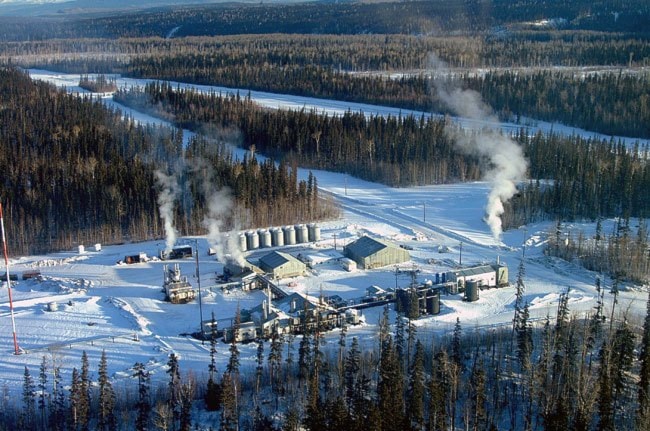The company in charge of the Kotaneelee gas processing plant has gone belly-up, which means the Yukon government is now the proud owner of a derelict gas well.
Houston-based EFLO Energy Inc. was ordered to clean up a spill originating from one of the pump houses at the Kotaneelee site in August 2015. That’s when the government discovered the company was unable to pay up.
“Subsequent to the spill, we determined EFLO was insolvent and unable to uphold its duties,” said John Fox, assistant deputy minister for oil and gas with the Department of Energy, Mines and Resources.
The Kotaneelee plant opened in 1977 and ceased production in 2012. In September 2014 ELFO submitted an application to the Yukon Environmental and Socio-economic Assessment Board to resume production at the site. By August 2015 the company was insolvent.
EFLO’s last available quarterly report to the United States Securities and Exchange Commission, filed in May 2015, listed the company as having $600,000 in proven assets, including $12,000 in cash, plus an additional $50.5 million in unproven petroleum assets.
EFLO held the licenses for all four wells at Kotaneelee at the time of the spill, Fox said. Licenses for three of the wells were turned over to Houston-based energy company, Apache, which, along with several other gas companies, held interests in the wells.
“We deemed Apache eligible to be license holder … and they accepted,” Fox said.
The fourth well, L38, could not be turned over to Apache because ELFO held a 100-per-cent stake in it. As a result, it has become the property and financial responsibility of EMR’s oil and gas branch.
All four wells are currently classed as shut in, meaning they aren’t operating but production could be restarted.
Both Apache and EMR have filed applications with YESAB to have the wells abandoned. The proposal is under assessment, which is expected to be completed by May 1.
EFLO had placed a well abandonment deposit of $625,000 on well L38. Fox said the Yukon government “will have to backstop” the cost of abandonment, then go after the EFLO’s creditors to be reimbursed.
“Realistically, no, we don’t think the current security will cover (the cost of abandonment) but we’ve budgeted for it,” Fox said.
A financial report on the estimated cost of abandoning L38 has not yet been completed.
Well abandonment is a “very significant problem” in places like Alberta, said Sebastian Jones, energy analyst for the Yukon Conservation Society. Alberta has an industry-backed abandonment fund, but it is “grossly inadequate” for the actual costs of cleaning up abandoned wells in that province, he said.
“It’s important to get a handle on this the issue of well abandonment before it really gets going,” Jones said. “The difficulties arise when a company disappears.”
The well is cemented in and the pipe capped three feet below ground, sealing it off. Following this, the infrastructure which was put in place for the wells is removed.
“When everything is over, an abandoned well (is supposed to be) returned as natural a state as possible. All the infrastructure must be removed,” Jones said.
Jones said it can be expensive to abandon wells in the Yukon, especially at remote sites like Kotaneelee, where everything has to be helicoptered in and out. He said wells sometimes need “reabandoning,” because the in initial work breaks down and fails, which is an extra expense not covered by abandonment deposits.
“This is one of those fiendish things that concerns me … permanent abandonment is not always permanent,” he said. “It’s not uncommon that within 50 years or so, wells need to be reabandoned … it’s a huge problem in the oil industry.”
It cost the government $2 million to reabandon well B62 — a remote drill site at Miner River west of Eagle Plains — in 2014, he said.
“Well B62 is a case study in just how expensive it can be to abandon a well in the Yukon,” Jones said. “If the bond (for L38) is inadequate, it’s because they didn’t ask for enough.”
The Kotaneelee spill involved more than 5,000 litres of fluid, mostly waste salt water with some lubricants used to extract natural gas, and EMR spokesperson said. Crews also extracted more than 240 tons of contaminated soil.
Cleanup efforts, paid for by Apache, are expected to be completed this fall after “extensive sampling,” which revealed that there were still contaminated “hotspots,” of hydrocarbons on the site, he said.
Potvin said the 2015 spill order is “yet to be fully complied with,” but Apache has “been very much engaged,” in the cleanup, he said.
Spill reports are confidential while the cleanup is taking place, Potvin said.
Contact Lori Garrison at lori.garrison@yukon-news.com
An earlier version of this story misspelled John Fox's name.
